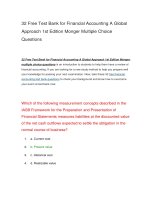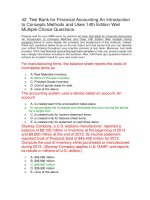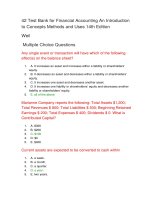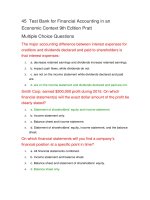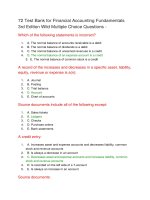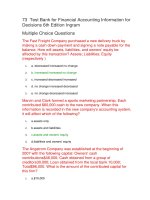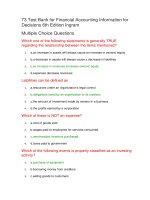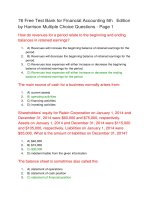Test bank for financial accounting a global approach 1st edition monger
Bạn đang xem bản rút gọn của tài liệu. Xem và tải ngay bản đầy đủ của tài liệu tại đây (101.68 KB, 20 trang )
Test Bank for Financial Accounting A Global Approach 1st
Edition Monger
Multiple Choice Questions
Which concept relates to the reporting of the effects of transactions when they
occur and not necessarily when cash is received or paid?
1.
a. Time period assumption
2.
b. Accrual basis
3.
c. Going concern
4.
d. Double-entry assumption
Which of the following measurement concepts described in the IASB
Framework for the Preparation and Presentation of Financial Statements
measures assets at an amount of cash or cash equivalents that would be paid if
they were acquired currently?
1.
a. Current cost
2.
b. Present value
3.
c. Historical cost
4.
d. Realizable value
The organization that is responsible for ensuring that IASB board members are
selected for the best combination of technical skills and background
experience on relevant international business and market conditions is the:
1.
a. IASC Foundation
2.
b. International Accounting Standards Board
3.
c. Standards Advisory Council
4.
d. International Financial Reporting Interpretations Committee
Lam Corporation owes Ling Ltd. ¥50,000. Ling owes Lam ¥45,000. Which of the
following is correct about reporting this information according to the IASB
Framework for the Preparation and Presentation of Financial Statements?
1.
a. Lam should report a negative trade accounts payable amount of ¥5,000
2.
b. Lam should report assets of ¥50,000
3.
c. Ling should report assets of ¥5,000
4.
d. Ling should report assets of ¥45,000
The qualitative characteristic of financial statements that describes information
that is free from material error and faithfully represents what it purports to
represent is which of the following?
1.
a. Reliability
2.
b. Relevance
3.
c. Understandability
4.
d. Comparability
Which of the following statements is not correct?
1.
a. Some nations have converged their national standards with International Financial
Reporting Standards
2.
b. Some nations have not converged their national standards with International Financial
Reporting Standards
3.
c. By the year 2012, all nations will be required to use International Financial Reporting
Standards
4.
d. Accounting standards are still established at the national level
Which of the following is not a characteristic of rules-based standards?
1.
a. Rules-based standards must be clear and understandable in their application and
enforcement
2.
b. Rules-based standards can be more flexibly applied in different jurisdictions
3.
c. Rules-based standards must be comprehensive to avoid gaps that fail to provide
guidance in all circumstances
4.
d. Critics believe that rules-based standards give management an incentive to apply
standards by the ‘letter of the law’ rather than in the ‘spirit of the law’
Which of the following is the correct sequence for obtaining authoritative
guidance when preparing financial statements according to the IASB
Framework for the Preparation and Presentation of Financial Statements? 1National standards other than IFRS 2- The Framework for the Preparation and
Presentation of Financial Statements 3- Public accountants 4- IFRS 5Management judgment
1.
a. 1, 2, 4 and then 3
2.
b. 1, 2, 4 and then 5
3.
c. 4, 2 and then 5
4.
d. 4, 1 and then 3
Faithful reprentations relates to which of the following qualitative characteristic
of financial statements?
1.
a. Reliability
2.
b. Relevance
3.
c. Understandability
4.
d. Comparability
Substance over form relates to which of the following qualitative characteristic
of financial statements?
1.
a. Reliability
2.
b. Relevance
3.
c. Understandability
4.
d. Comparability
If the omission or misstatement could influence the economic decisions of
users on the basis of financial statements, then information is which of the
following?
1.
a. Timely
2.
b. Material
3.
c. Relevant
4.
d. Reliable
Which of the following measurement concepts described in the IASB
Framework for the Preparation and Presentation of Financial Statements
measures assets based on the amount of cash or cash equivalents that would
be paid if they were acquired currently?
1.
a. Current cost
2.
b. Present value
3.
c. Historical cost
4.
d. Realizable value
International Financial Reporting Standards (IFRS) are now established by:
1.
a. the International Monetary Fund
2.
b. the International Accounting Standards Committee
3.
c. the IASC Foundation
4.
d. the International Accounting Standards Board
Which of the following measurement concepts described in the IASB
Framework for the Preparation and Presentation of Financial Statements
measures liabilities by the amount of proceeds exchanged for the obligation?
1.
a. Current cost
2.
b. Present value
3.
c. Historical cost
4.
d. Realizable value
The qualitative characteristic of financial statements that assumes that users
have a reasonable knowledge of business, economic activities and financial
accounting, and will study the information with reasonable diligence to
comprehend its meaning is which of the following?
1.
a. Reliability
2.
b. Relevance
3.
c. Understandability
4.
d. Comparability
Which concept relates to the assumption that a business entity will continue to
operate without threat of liquidation in the foreseeable future?
1.
a. Accrual basis
2.
b. Going concern
3.
c. Entity assumption
4.
d. Reporting assumption
Which of the following is not a constraint on relevant and reliable information
as identified in the IASB Framework for the Preparation and Presentation of
Financial Statements?
1.
a. Fair presentation
2.
b. Balance between qualitative characteristics
3.
c. Prudence
4.
d. Timeliness
Which of the following measurement concepts described in the IASB
Framework for the Preparation and Presentation of Financial Statements
measures assets at the discounted value of future net cash inflows that the
asset is expected to generate?
1.
a. Current cost
2.
b. Present value
3.
c. Historical cost
4.
d. Realizable value
Which of the following is not an objective of the International Accounting
Standards Board?
1.
a. Promote the use and rigorous application of IFRS
2.
b. Follow directives issued by national accounting standards organizations
3.
c. Develop a single set of high quality, understandable and enforceable global standards
4.
d. Work actively with national standard-setters to bring about convergence of national
accounting standards with IFRS
Neutrality relates to which of the following qualitative characteristic of financial
statements?
1.
a. Reliability
2.
b. Relevance
3.
c. Understandability
4.
d. Comparability
Which of the following is not a characteristic of principles-based standards?
1.
a. Principles-based standards provide specific guidelines for those who prepare financial
statements
2.
b. Critics believe that principles-based standards create some uncertainty about whether
a company is in compliance or not
3.
c. Critics believe that management has too much latitude in the application of principlesbased standards
4.
d. With principles-based standards, it is easier to have implementations that satisfy local
laws and culture
Which of the following measurement concepts described in the IASB
Framework for the Preparation and Presentation of Financial Statements
measures liabilities at the amount of cash or cash equivalents that would be
needed to settle the obligation in the normal course of business?
1.
a. Current cost
2.
b. Present value
3.
c. Historical cost
4.
d. Realizable value
Consistency relates to which of the following qualitative characteristic of
financial statements?
1.
a. Reliability
2.
b. Relevance
3.
c. Understandability
4.
d. Comparability
Which of the following measurement concepts described in the IASB
Framework for the Preparation and Presentation of Financial Statements
measures assets based on an amount of cash or cash equivalents paid or the
fair value of the consideration given to acquire them?
1.
a. Current cost
2.
b. Present value
3.
c. Historical cost
4.
d. Realizable value
Which of the following is not a mandatory step in the IASB standard-setting
process?
1.
a. Establishing procedures for reviewing comments made within a reasonable period on
documents published for comment.
2.
b. Publishing bases for conclusions with standards and exposure drafts.
3.
c. Preparing and issuing standards and exposure drafts, each of which is to include any
dissenting opinions.
4.
d. Publishing a discussion document
Prudence relates to which of the following qualitative characteristic of financial
statements?
1.
a. Reliability
2.
b. Relevance
3.
c. Understandability
4.
d. Comparability
Which of the following are requirements for developing international
accounting standards? 1- Extensive consultation and responsiveness 2Transparency and accessibility 3- Accountability 4- Collating responses to
discussion papers and exposure drafts
1.
a. 1, 2 and 3 only
2.
b. 2, 3 and 4 only
3.
c. 1, 2 and 4 only
4.
d. All four are requirements
Qualitative characteristics that make information provided in financial
statements useful to users include which of the following: 1- relevance 2integrity 3- understandability 4- cost effectiveness 5- comparability 6timeliness 7- reliability
1.
a. 2, 4, 6 and 7
2.
b. 1, 2, 5 and 6
3.
c. 2, 3, 4 and 7
4.
d. 1, 3, 5 and 7
Completeness relates to which of the following qualitative characteristic of
financial statements?
1.
a. Reliability
2.
b. Relevance
3.
c. Understandability
4.
d. Comparability
International Financial Reporting Standards (IFRS) include all except which of
the following:
1.
a. interpretations by the International Financial Reporting Interpretations Committee
2.
b. Pronouncements by the Standards Advisory Council
3.
c. International Financial Reporting Standards (IFRS) as currently established by the
IASB
4.
d. International Accounting Standards
Which of the following measurement concepts described in the IASB
Framework for the Preparation and Presentation of Financial Statements
measures liabilities at the discounted value of the net cash outflows expected
to settle the obligation in the normal course of business?
1.
a. Current cost
2.
b. Present value
3.
c. Historical cost
4.
d. Realizable value
Which of the following measurement concepts described in the IASB
Framework for the Preparation and Presentation of Financial Statements
measures liabilities at the amount of cash or cash equivalents that would
currently be required to settle the obligation?
1.
a. Current cost
2.
b. Present value
3.
c. Historical cost
4.
d. Realizable value
True- False Questions
On 25 April 2010, employees provide services to a company for €15,000. The
company pays for these services on 4 May 2010. Under accrual basis
accounting, the effect of these services will be reported in May 2010.
1.
True
2.
False
The IASC Foundation creates international accounting standards.
1.
True
2.
False
Publishing a discussion document is a non-mandatory step in the IASB
standard-setting process.
1.
True
2.
False
International Financial Reporting Standards (IFRS) include International
Financial Reporting Standards provided by the International Accounting
Standards Board (IASB) but not International Accounting Standards (IAS) that
were established by the International Accounting Standards Committee (IASC)
that preceded the IASB.
1.
True
2.
False
An external user assumes that IFRS have been used to prepare financial
statement unless there is an explicit and unreserved statement in the notes to
the financial statements than another accounting standard was used.
1.
True
2.
False
International Financial Reporting Standards (IFRS) require that a business
present a complete set of financial statement at least once annually even
though the business may elect to present financial statement more frequently.
1.
True
2.
False
A major criticism of rules-based standards is that management has too much
latitude in their application and therefore uncertainty is created about whether
a company is in compliance or not.
1.
True
2.
False
Undertaking field tests both in developed countries and emerging markets is a
mandatory step in the IASB standard-setting process.
1.
True
2.
False
International Financial Reporting Standards (IFRS) require that a business
present at least three years’ comparable information when the business
presents its annual financial statements.
1.
True
2.
False
The two underlying assumptions in the Framework for the Preparation and
Presentation of Financial Statements are going concern and accrual basis.
1.
True
2.
False
In accounting, information is material if omission or misstatement of that
information could influence the economic decisions of users.
1.
True
2.
False
Under historical cost, liabilities are measured by the amount of proceeds
exchanged for the obligation.
1.
True
2.
False
Present value means that assets are carried at the discounted value of future
net cash inflows that the asset is expected to generate, while liabilities are
carried at the discounted value of the net cash outflows expected to settle the
obligation in the normal course of business.
1.
True
2.
False
The accrual basis of accounting requires that transactions be recorded in the
period when payment is received or made by the company.
1.
True
2.
False
International accounting standards use a principle-based approach.
1.
True
2.
False
Principles-based standards are criticized because management has an
incentive to apply them by the ‘letter of the law’ rather than the ‘spirit of the
law’ as a means of circumventing certain requirements.
1.
True
2.
False
A reporting entity is normally not allowed to offset assets and liabilities.
1.
True
2.
False
One constraint on relevant and reliable information as defined by the
Framework for the Preparation and Presentation of Financial Statements is that
financial statements should present a true and fair view.
1.
True
2.
False
Consulting the Standards Advisory Committee on major projects, agenda
decisions and work priorities is a mandatory step in the IASB standard-setting
process.
1.
True
2.
False
One constraint on relevant and reliable information as defined by the
Framework for the Preparation and Presentation of Financial Statements is
prudence.
1.
True
2.
False
International Financial Reporting Standards (IFRS) are set by the International
Accounting Standards Board (IASB).
1.
True
2.
False
One issue within professional ethics is whether professionals including
accountants are able to make independent judgments about their work.
1.
True
2.
False
Publishing bases for conclusions with standards and exposure drafts is a nonmandatory step in the IASB standard-setting process.
1.
True
2.
False
One constraint on relevant and reliable information as defined by the
Framework for the Preparation and Presentation of Financial Statements is
timeliness.
1.
True
2.
False
The three levels of authoritative guidance listed in order are IFRS, the
Framework for the Preparation and Presentation of Financial Statements and
management judgment.
1.
True
2.
False
The four qualitative characteristics of financial statements defined by the
Framework for the Preparation and Presentation of Financial Statements are 1)
comparability, 2) relevance, 3) reliability and 4) understandability.
1.
True
2.
False
Going concern refers to the assumption that a business entity will continue
operating without threat of liquidation in the foreseeable future.
1.
True
2.
False
Realizable value means that assets are recorded for an amount of cash or cash
equivalents paid or the fair value of the consideration given to acquire them.
1.
True
2.
False
International Financial Reporting Standards (IFRS) include International
Financial Reporting Standards provided by the International Accounting
Standards Board (IASB) as well as International Accounting Standards (IAS),
interpretations by the International Financial Reporting Interpretations
Committee (IFRIC) and the former Standing Interpretations Committee.
1.
True
2.
False
Accounting standards were previously set at the national level but now are all
established at the international level.
1.
True
2.
False
The Framework for the Preparation and Presentation of Financial Statements is
an example of one accounting standard established by the International
Accounting Standards Board (IASB).
1.
True
2.
False
A major advantage of principles-based standards is that they are flexible
enough to be applied in different jurisdictions, each of which can have its own
implementation of the standard in a way that satisfied local laws and culture.
1.
True
2.
False
Holding public hearings is a mandatory step in the IASB standard-setting
process.
1.
True
2.
False
International Financial Reporting Standards (IFRS) interpretations by the
International Financial Reporting Interpretations Committee (IFRIC).
1.
True
2.
False
Advice provided by the Standards Advisory Council is considered to be part of
International Financial Reporting Standards (IFRS).
1.
True
2.
False
